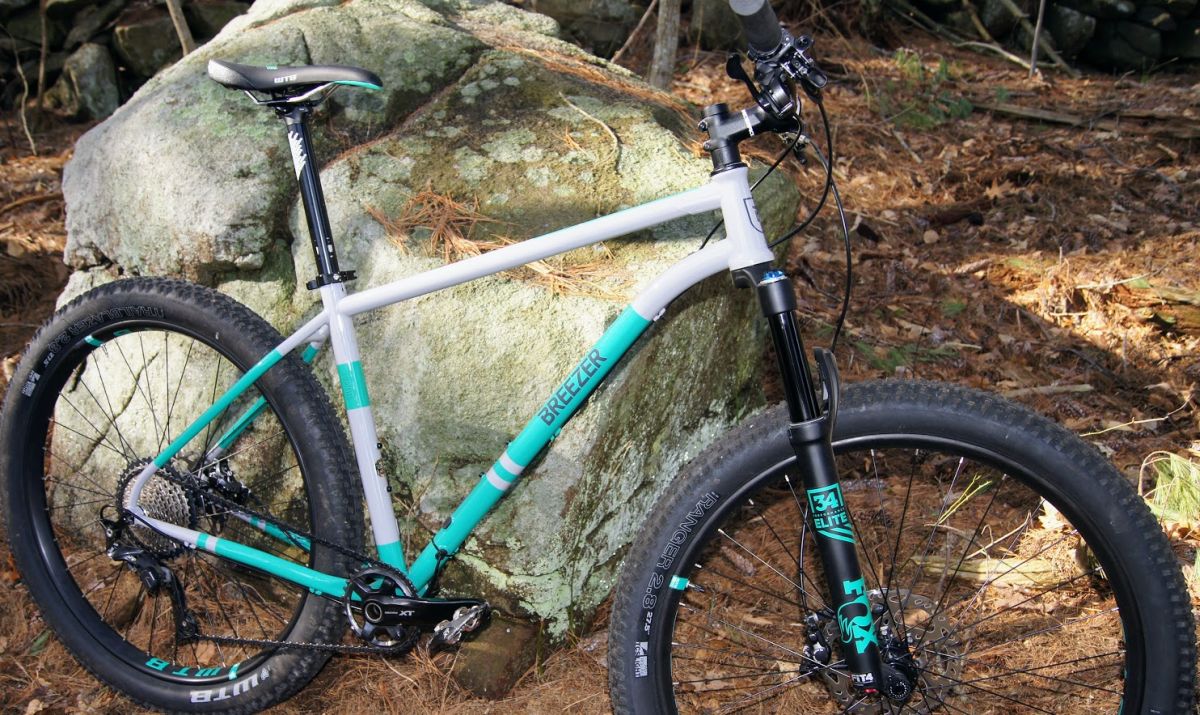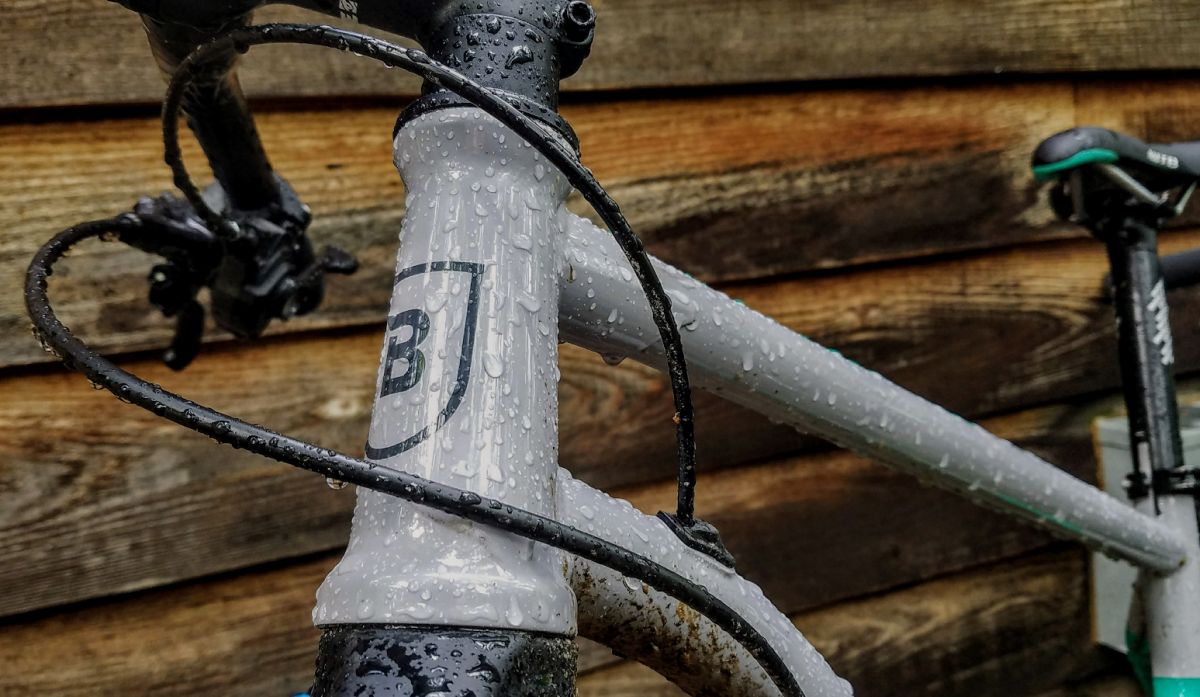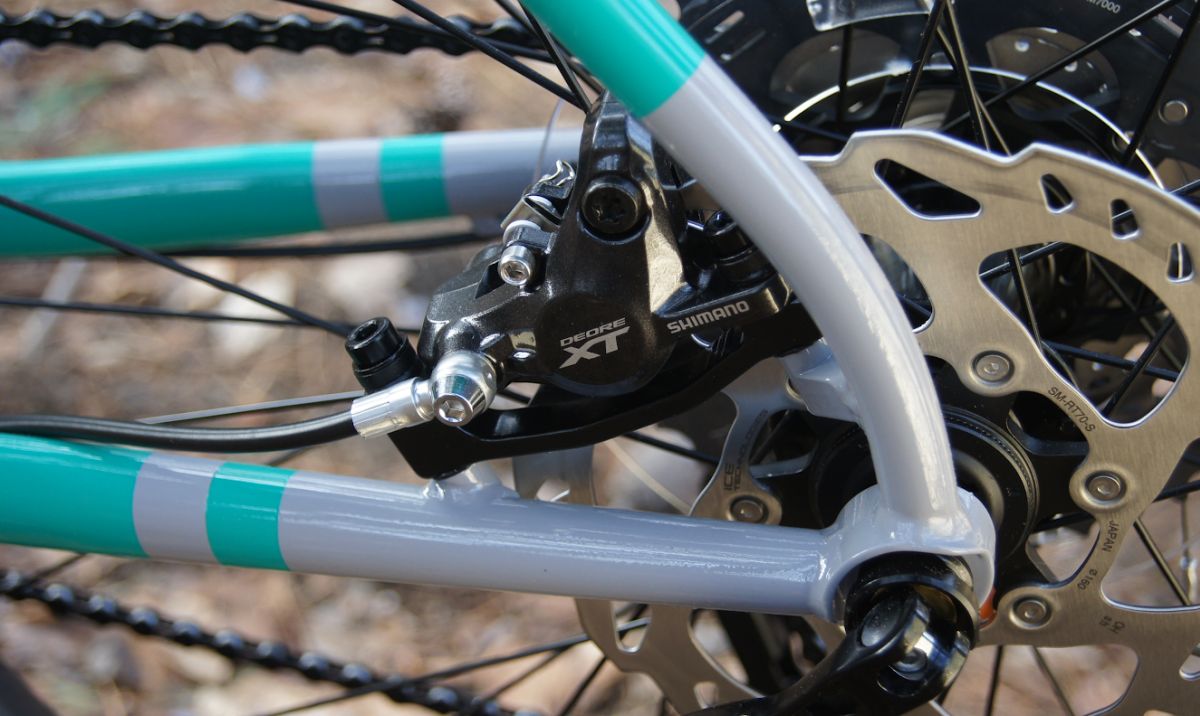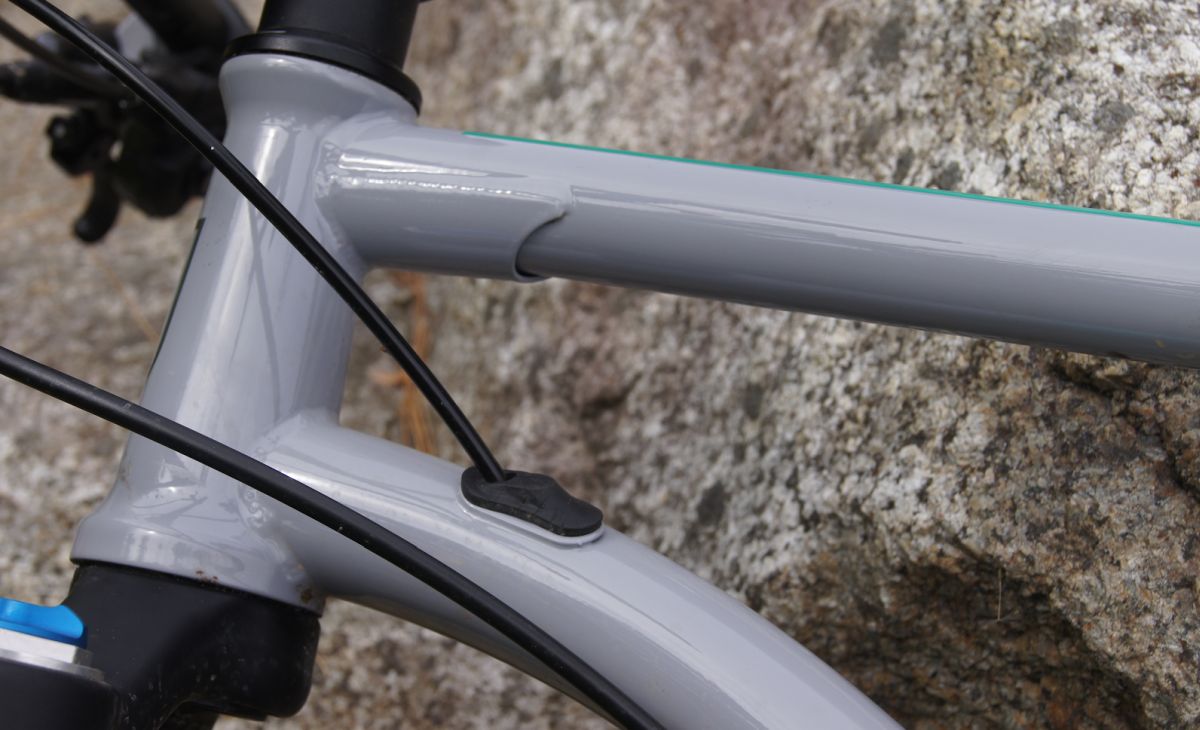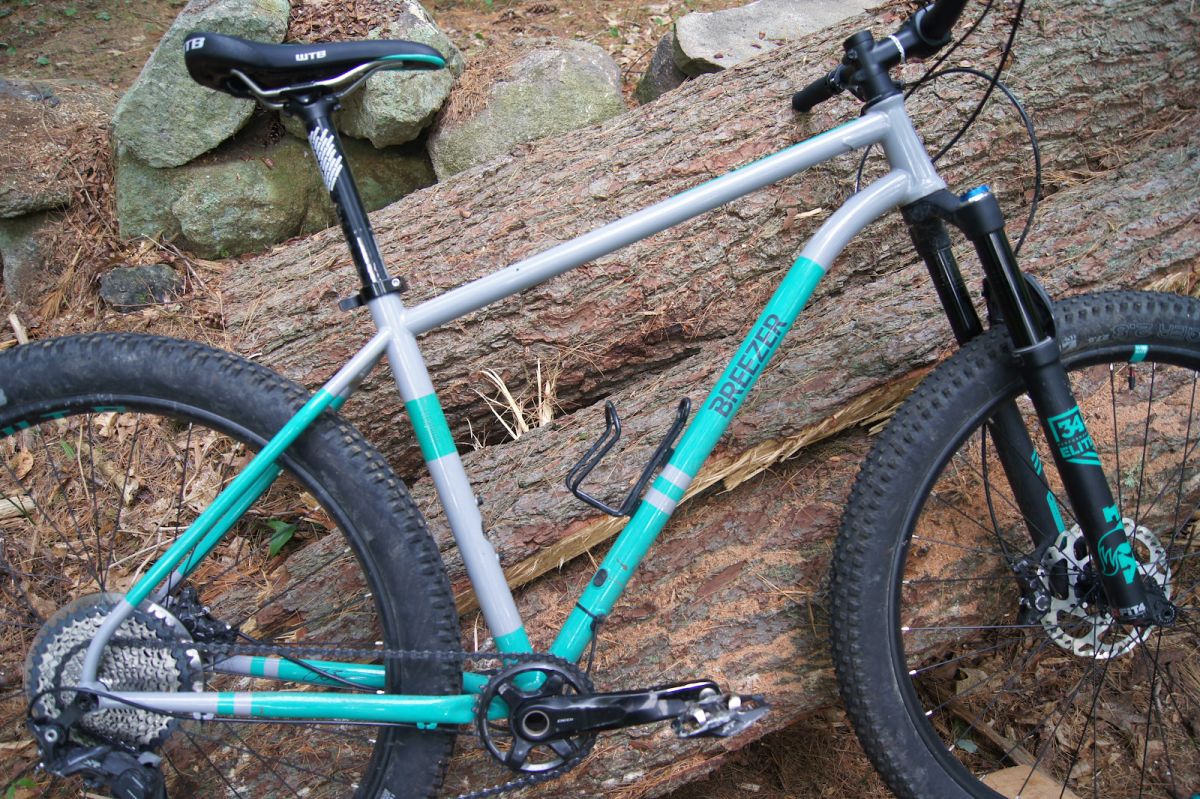Joe Breeze has been making lustworthy mountain bikes from the get-go. The 2018 Lightning is a reboot of one his classic steel hardtails. One my favorite bikes of all time was a 1995 Lightning. This updated 27.5+ version retains some of Joe’s early innovations and classic style, but has been updated so today’s riders can hit speeds that 1995-me couldn’t have touched.
With thick coats of gray and green paint on the cromoly tubing, the new Lightning has timeless good looks.The tubing diameter looks narrow compared to the much fatter alloy and carbon frames dominating the market, so you might worry about unwanted frame flex. But with 2.8” squishy tires, it’s hard to discern any flex, beyond maybe some welcomed softening of hard landings. The Lightning employs D’Fusion tubing which Breezer introduced in the 90’s (predating all the hydroformed alloy rigs I can think of), so he has years of experience balancing the strength and weight of steel frames. Another blast from the past are the updated Breeze-Thru dropouts, which are a thru-axle version of the iconic and often copied Breeze-In hooded dropouts.
With a svelte toptube gusset, tapered headtube, 148 Boost rear axle spacing, and internal cable routing, this modern Lightning proves that steel can still be real and relevant. Internal cable routing means more places for water to get into a steel frame, but you can still buy J.P. Weigle Frame Saver, so I’m down with it. At 28.8lbs for the 18.5” bike, the overall weight is competitive with the current field of plus-wheeled alloy hardtails (and even some carbon ones). Not light, but it’s the unavoidable trade-off to the big-wheels that Boost spacing allows.
While the frame might look a bit retro with the narrow tubes, it’s in line with current trail bike geometry, with the one exception of its steep 69° head angle. There may be some comments on this, but with short chainstays and a very low slung BB, the overall numbers are in sync with a trail bike designed to go fast both down and up hills.
The parts spec on the $3,219 Lightning 27.5+ is a good value. I had become addicted to dropper posts, and with internal cable routing, the Lightning screams for one, so that’s my only real gripe with the spec. With a Fox 34 Elite 120mm fork, and Shimano XT drivetrain and brakes, the Breezer is still very well stocked. It’s a personal preference, but I like the tight modulation on the Shimano brakes, which have tons of stopping power (180 front rotors and 160 rear). And I had no issues with the XT 1×11 drivetrain, which had adequate range for my daily trail riding and short punchy climbs (11×42 cassette with a 32 chainring). The Fox 34 Elite 120mm fork is a workhorse, and is only a Kashima coating shy of the pricier Factory version, so it’s a good value. Race Face provides the stem (80mm), handlebars (760mm), and seatpost (30.9).
WTB supplies the wheelsets and comfy Volt Race saddle, which is another personal favorite of mine. WTB ASYM i35 rims and WTB tires pair well (as they should), and have tight tolerances that made for easy tubeless setup with a floor pump (but did require bionic thumbs to get the tires on). The 27.5 wheels with 2.8” tires had tons of clearance, so I swapped out the high and tight Trailblazer in the back for something nobbier for better out-of-the-saddle traction. I liked the rounder Ranger on the front, and seems like two of them might have worked fine (but maybe there’s logic to running the smooth side-walled Trailblazer in the rear, where it might help ensure the rear slides out before the front). Overall, while I nitpicked a bit on the lack of dropper and tire choice, it’s a good build package for the money, and there is a lower priced Pro build up with SLX and Rockshox Revelation fork if you need to keep to a budget.
I still have vivid 1995 memories of descending Porcupine Rim and Mt Tam on that older Lightning, holding my own against fast guys on new-fangled dual-suspension bikes. If only I had this new 27.5+ bike back then. With this in mind, I brought the Lightning along for a few days of riding in Stokesville, VA, for some serious descending. However, bringing this knife of a bike to an enduro fight wasn’t my best idea. No fault of the Lightning, which is great trail bike, perfectly suited for its intended use. I just couldn’t hang with dual-squishies through the loooong downhill rock gardens, where my arms and legs felt like they were strapped to paint shaking machines. Kudos to the Lightning for getting me home in one piece, because even after dialing it back some, I was still ripping down gnarly terrain that even Johnny T and Missy would have thought twice about.
Back at home, the Lightning was the perfect tool for the job of riding my everyday trail bike trails. It excelled on low-speed technical New England rocks and roots, without the floppy feel of a super slack angled bike. The Breezer also handled well at higher speeds on my occasional trips to flow trails. It strikes a good bargain between being great in the woods, and not afraid to rip downhills… within 120mm hardtail limits.
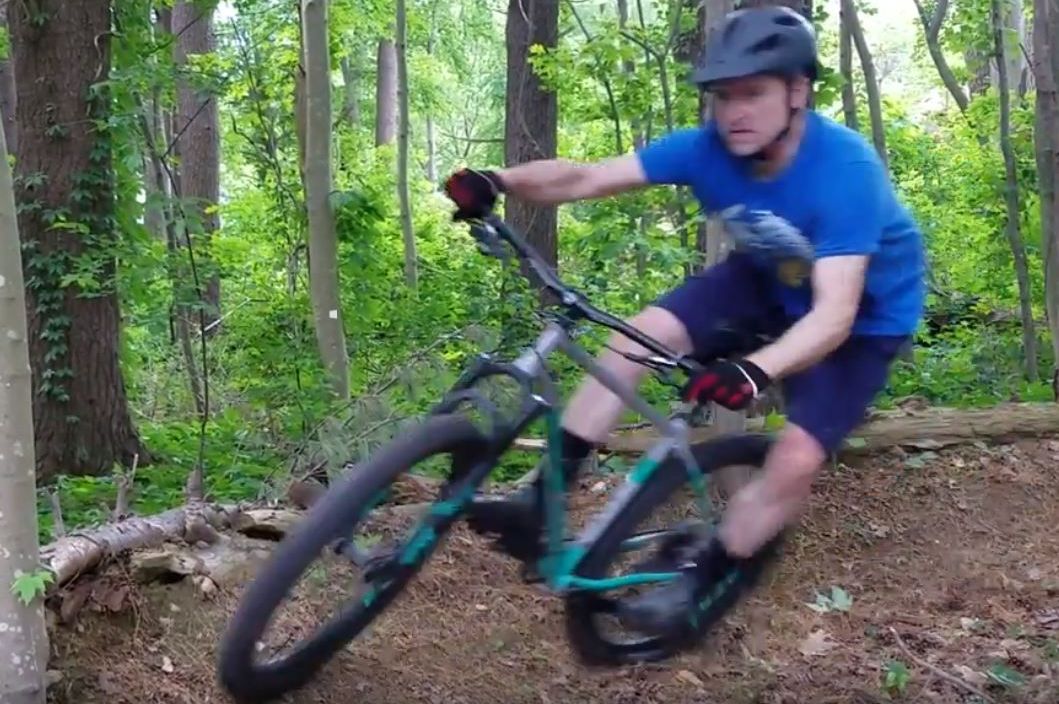 It took a few rides, but I eventually detoxed from the lack of dropper, and came to a happy place with a slightly lower saddle than usual (rock bottom was digging through the parts bin looking for a 1990’s Hite-Rite). The Lightning was great for slicing and dicing through the granite boulders of my hometown trails. And once I got my body and saddle position dialed in, the bike handled berms, log hops, and small drops as well as any trail bike I’ve had. I’m a fan of the confidence inspiring plus tires, and the Lightning felt quick and efficient, despite the big, rumbling tires. Those looking for more speed or gravel grinding could go for a skinnier tire 29er setup (framesets sell for $999). But the bike is built for trail riding, and it held up to enduro-style abuse as well as my tendency to case doubles and overshoot singles on jumpy trails.
It took a few rides, but I eventually detoxed from the lack of dropper, and came to a happy place with a slightly lower saddle than usual (rock bottom was digging through the parts bin looking for a 1990’s Hite-Rite). The Lightning was great for slicing and dicing through the granite boulders of my hometown trails. And once I got my body and saddle position dialed in, the bike handled berms, log hops, and small drops as well as any trail bike I’ve had. I’m a fan of the confidence inspiring plus tires, and the Lightning felt quick and efficient, despite the big, rumbling tires. Those looking for more speed or gravel grinding could go for a skinnier tire 29er setup (framesets sell for $999). But the bike is built for trail riding, and it held up to enduro-style abuse as well as my tendency to case doubles and overshoot singles on jumpy trails.
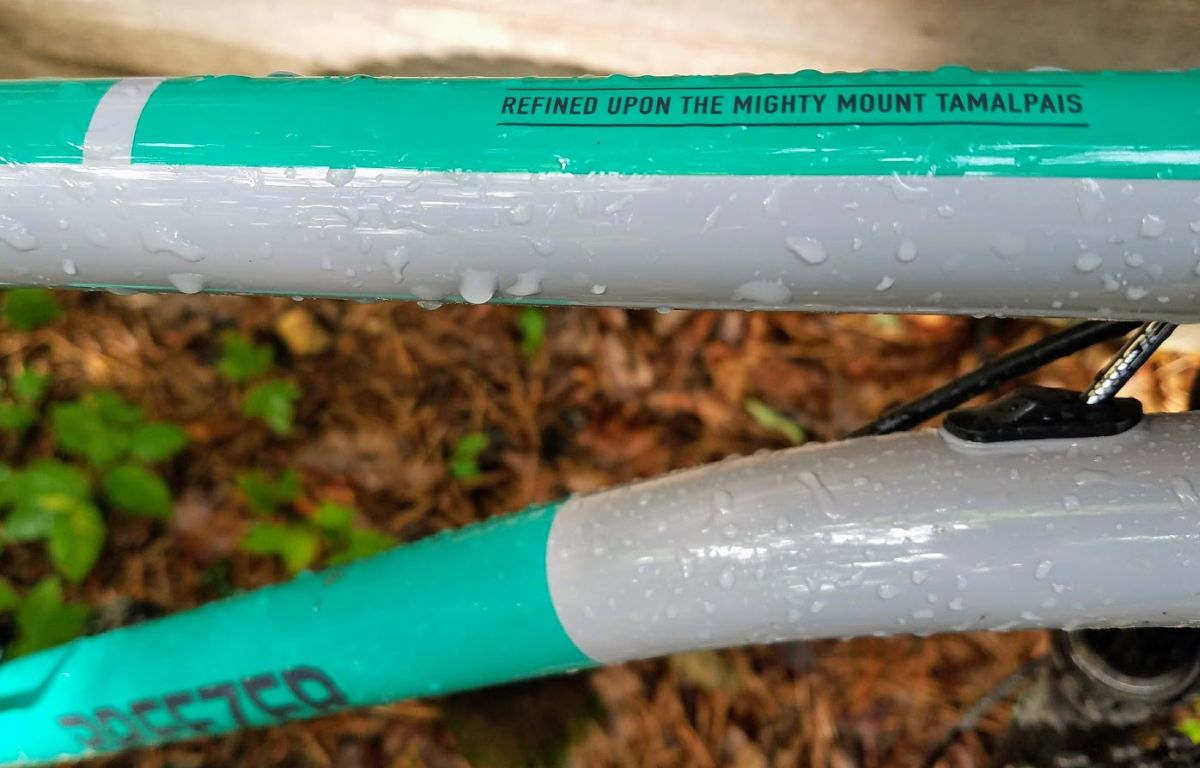 Overall, the 2018 Lightning 27.5+ Team is a killer trail bike with classic looks and heritage. With 40 years of mountain bike building experience, Joe continues to innovate and produce gorgeous bikes that are chock full of tradition and soul.
Overall, the 2018 Lightning 27.5+ Team is a killer trail bike with classic looks and heritage. With 40 years of mountain bike building experience, Joe continues to innovate and produce gorgeous bikes that are chock full of tradition and soul.
Updates: For 2019, the Lightning will ship with a dropper seatpost. Also, you can check out a special GX Eagle build exclusive to JensonUSA for $1,649.
